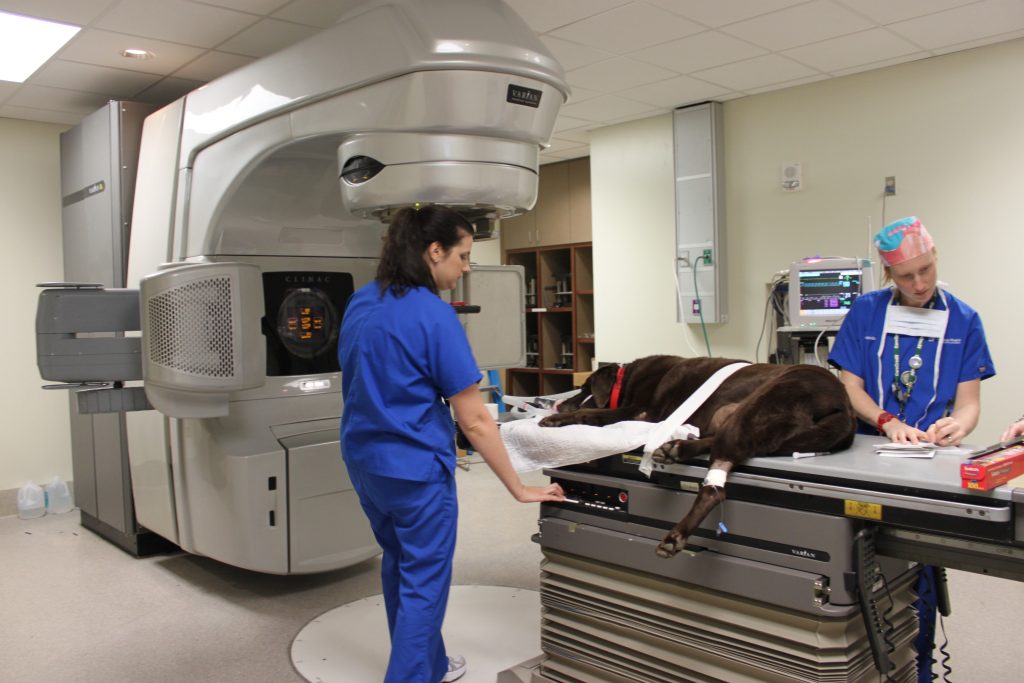Pets are family members. Pet owners often expect (and demand) the same level of state-of-the-art care for their dogs and cats that they themselves receive. One such type of intervention is stereotactic radiosurgery (SRS). This week’s post is dedicated to sharing information about this type of therapy since it’s becoming more available around the world. I hope you find this post fascinating – happy reading!

What is stereotactic radiosurgery?
Despite its name, stereotactic radiosurgery does not involve the use of a scalpel blade, nor does a veterinarian make an incision in your pet. Rather, SRS is a form of radiation therapy that damages deoxyribonucleic acid (DNA) of targeted cells, causing them to shrink because they lose their ability to reproduce.
Three types of machines can be used to deliver radiation therapy during SRS:
- Linear accelerator (LINAC) – These machines use photons to treat targeted sites. They are often referred to by the name of their manufacturer, most commonly CyberKnife and TrueBeam.
- Gamma Knife – These machines use a myriad of beams (typically 192 or 201) of gamma rays to treat targeted sites.
- Proton Beam Therapy – Also called charged particle radiosurgery, this newest form of SRS is not yet commonly available in the United States, but availability is growing.

How does stereotactic radiosurgery work?
Specialized equipment delivers precisely focused beams of radiation to treat tumors and other problems in the brain, spine, and other parts of the body. Each beam has minimal effect on tissue as it passes through but a precise and targeted dose of radiation is delivered to the site where all of the beams intersect.
The radiation delivered to the affected site causes tumors to shrink. The radiation also cuts tumors off from their blood supply by causing blood vessels at the site to close. Given the precision of SRS, surrounding healthy tissue is minimally affected.
When does my pet need SRS?
A myriad of tumors in dogs and cats in a wide variety of locations may be successfully treated with stereotactic radiosurgery. Common tumors that may benefit from SRS include:
- Squamous cell carcinoma
- Mast cell tumors
- Soft tissue sarcomas
- Injection site sarcoma
- Infiltrative lipomas
- Pituitary tumors
- Nasal tumors
- Brain tumors
- Thyroid tumors
- Oral melanomas
- Osteosarcoma

Pet owners are strongly encouraged seek consultation with a board-certified veterinary oncologist or radiation oncologist to learn if their pet could benefit from stereotactic radiosurgery.
The take-away message about SRS in dogs and cats…
Stereotactic radiosurgery or SRS is a newer state-of-the-art form of radiation therapy that can be used to treat dogs and cats with a variety of tumors. Availability of this treatment modality is increasing around the world, and as such, animal health is improving. Pet owners interested in SRS should partner their family veterinarian and a board-certified veterinary cancer specialist.
To find a board-certified veterinary oncologist, please visit the American College of Veterinary Internal Medicine.
To find a board-certified veterinary radiation oncologist, please visit the American College of Veterinary Radiology.
Wishing you wet-nosed kisses,
CriticalCareDVM







